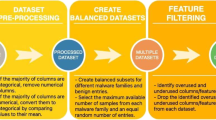Abstract
The Android operating system boosts a global market share over the previous years, which has made it the most popular operating system in the world. Recently, Android has become the target of attacks by cybercriminals because of its open-source code and its progressive growth. Many machine learning techniques have been used to address this issue in the Android operating system. However, a limited range of feature selection methods has been used in these systems. This paper, therefore, aims to address and evaluate the impact of a multi-objective feature selection approach called NSGAII in Android malware detection systems. To improve the diversity of solutions offered by this method, we have modified the standard NSGAII approach. Experimental results show that the proposed method can lead to better malware classification.
Access this chapter
Tax calculation will be finalised at checkout
Purchases are for personal use only
Similar content being viewed by others
References
Mobile Operating System Market Share Worldwide. https://gs.statcounter.com/os-market-share/mobile/worldwide. Accessed 13 Apr 2020
Feizollah, A., Anuar, N.B., Salleh, R., Wahab, A.W.A.: A review of feature selection in mobile malware detection. Digital Invest. 13, 22–37 (2015)
Cai, J., Luo, J., Wang, S., Yang, S.: Feature selection in machine learning: a new perspective. Neurocomputing 300, 70–79 (2018)
Chandrashekar, G., Sahin, F.: A survey on feature selection methods. Comput. Electr. Eng. 40(1), 16–28 (2014)
Golrang, A., Golrang, A.M., Yayilgan, S.Y., Elezaj, O.: A novel hybrid IDS based on modified NSGAII-ANN and random forest. Electronics 9(4), 577 (2020)
Wang, W., et al.: Constructing features for detecting android malicious applications: issues, taxonomy and directions. IEEE Access 7, 67602–67631 (2019)
Xue, B., Zhang, M., Browne, W.N., Yao, X.: A survey on evolutionary computation approaches to feature selection. IEEE Trans. Evol. Comput. 20(4), 606–626 (2015)
Huang, B., Buckley, B., Kechadi, T.M.: Multi-objective feature selection by using NSGA-II for customer churn prediction in telecommunications. Expert Syst. Appl. 37(5), 3638–3646 (2010)
Coronado-De-Alba, L.D., Rodr’ıguez-Mota, A., Escamilla-Ambrosio, P.J.: Feature selection and ensemble of classifiers for Android malware detection. In: 2016 8th IEEE Latin-American Conference on Communications (LATIN- COM), pp. 1–6. IEEE, November 2016
VIRUSTOTAL. https://www.virustotal.com/gui/home/upload. Accessed 13 Apr 2020
Zhao, K., Zhang, D., Su, X., Li, W., Fest: a feature extraction and selection tool for Android malware 373 detection. In: IEEE Symposium on Computers and Communication (ISCC), vol. 2015, pp. 714–720. IEEE (2015)
Qiao, M., Sung, A.H., Liu, Q.: Merging permission and API features for Android malware detection. In: 2016 5th IIAI International Congress on Advanced Applied Informatics (IIAI-AAI), pp. 566–571. IEEE, July 2016
Cen, L., Gates, C.S., Si, L., Li, N.: A probabilistic discriminative model for android malware detection with decompiled source code. IEEE Trans. Dependable Secure Comput. 12(4), 400–412 (2014)
Arp, D., Spreitzenbarth, M., Hubner, M., Gascon, H., Rieck, K., Siemens, C.E.R.T.: DREBIN: effective and explainable detection of Android malware in your pocket. In: NDSS, vol. 14, pp. 23–26, February 2014
Zhou, Y., Jiang, X.: Dissecting android malware: characterization and evolution. In: 2012 IEEE Symposium on Security and Privacy, pp. 95–109. IEEE, May 2012
Chaiyaratana, N., Piroonratana, T., Sangkawelert, N.: Effects of diversity control in single-objective and multi-objective genetic algorithms. J. Heuristics 13(1), 1–34 (2007)
Yerima, S.Y.; Sezer, S. DroidFusion: a novel multilevel classifier fusion approach for Android malware 384 detection. IEEE Trans. Cybern. 49(2), 453–466 (2018)
Author information
Authors and Affiliations
Corresponding author
Editor information
Editors and Affiliations
Rights and permissions
Copyright information
© 2021 Springer Nature Switzerland AG
About this paper
Cite this paper
Golrang, A., Yayilgan, S.Y., Elezaj, O. (2021). The Multi-objective Feature Selection in Android Malware Detection System. In: Yildirim Yayilgan, S., Bajwa, I.S., Sanfilippo, F. (eds) Intelligent Technologies and Applications. INTAP 2020. Communications in Computer and Information Science, vol 1382. Springer, Cham. https://doi.org/10.1007/978-3-030-71711-7_26
Download citation
DOI: https://doi.org/10.1007/978-3-030-71711-7_26
Published:
Publisher Name: Springer, Cham
Print ISBN: 978-3-030-71710-0
Online ISBN: 978-3-030-71711-7
eBook Packages: Computer ScienceComputer Science (R0)




